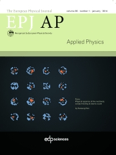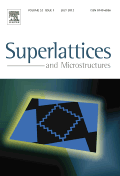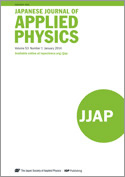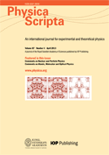
Micro and Nanostructures
Scope & Guideline
Bridging Science and Innovation at the Nanoscale
Introduction
Aims and Scopes
- Microelectronics and Device Engineering:
Research on the design, optimization, and performance evaluation of microelectronic devices, including transistors, sensors, and integrated circuits. - Nanomaterials and Nanostructures:
Exploration of novel nanomaterials, their synthesis, characterization, and potential applications in various fields such as photovoltaics, sensing, and electronics. - Theoretical and Computational Modeling:
Studies employing theoretical and computational methods to predict and analyze the properties of micro and nanoscale systems, aiding in device design and optimization. - Optoelectronics and Photonics:
Research on devices that utilize light, such as LEDs, photodetectors, and solar cells, focusing on their efficiency, materials, and innovative designs. - Sensors and Biosensors:
Development and analysis of advanced sensing technologies, including gas sensors, biosensors, and their applications in environmental and healthcare monitoring. - Quantum and Spintronics Devices:
Investigation into devices that exploit quantum effects and spin properties for advanced functionalities in electronics and information technology.
Trending and Emerging
- Advanced 2D Materials and Heterostructures:
There is a growing interest in the use of two-dimensional materials, such as graphene and transition metal dichalcogenides, for their unique electronic and optical properties in various applications. - Quantum Dot and Nanocrystal Applications:
Research on quantum dots and nanocrystals for applications in photovoltaics, LEDs, and other optoelectronic devices is gaining momentum, driven by their tunable properties. - Machine Learning and AI in Device Design:
The integration of machine learning techniques for predicting device performance and optimizing material properties is increasingly prevalent, signaling a shift towards data-driven research. - Sustainable and Eco-Friendly Materials:
An emerging trend towards the use of eco-friendly materials and processes in device fabrication, particularly in the context of photovoltaics and sensing technologies. - Wearable and Flexible Electronics:
Research focused on the development of flexible and wearable electronic devices is on the rise, driven by advancements in materials science and consumer demand.
Declining or Waning
- Traditional Semiconductor Materials:
Research centered on conventional semiconductor materials like silicon and gallium arsenide is becoming less frequent, as the focus shifts towards novel materials and heterostructures. - Basic Photovoltaic Technologies:
Studies related to basic solar cell technologies without innovative materials or structures are waning, giving way to more advanced concepts like perovskite and tandem solar cells. - Conventional MOSFET Designs:
Publications focusing purely on traditional MOSFET designs, without enhancements or novel approaches, are decreasing as the field moves towards more innovative transistor architectures.
Similar Journals

Frontiers of Physics
Pioneering Discoveries in the Realm of PhysicsFrontiers of Physics, published by Higher Education Press, is a premier open-access journal dedicated to fostering innovative research and excellence within the field of physics. With an ISSN of 2095-0462 and an E-ISSN of 2095-0470, this rapidly growing journal has established itself as a valuable platform for disseminating cutting-edge findings, covering a diverse range of topics from theoretical frameworks to experimental advancements. Notably, Frontiers of Physics has achieved an impressive Q1 ranking in the 2023 Scopus Quartiles for Physics and Astronomy, securing a competitive 5th out of 81 positions in its category, reflecting a high impact factor that underscores its importance to the scientific community. Since its inception in 2011 and continuing through 2024, the journal aims to bridge the gap between academia and industry, encouraging collaboration among researchers, professionals, and students alike. Its commitment to open access ensures that high-quality research is readily accessible, thereby promoting knowledge sharing and advancement in the global physics community. Explore the potential of your research in Frontiers of Physics, where the future of physics flourishes.

Optoelectronics Letters
Connecting Scholars in the Evolving World of OptoelectronicsOptoelectronics Letters, published by Tianjin University of Technology, is an esteemed platform for the dissemination of innovative research within the fields of atomic and molecular physics, optics, condensed matter physics, and electrical engineering. With its inaugural publication in 2007 and a convergence period extending to 2024, this journal aims to foster scholarly communication and collaboration among researchers and professionals. Although currently lacking an impact factor, it serves a vital niche in the rapidly evolving field of optoelectronics, evidenced by its categorization in the fourth quartile for various physics disciplines and the third quartile in electrical and electronic engineering. Given its ranking dynamics in Scopus, it is an emerging choice for authors seeking to convey their findings on electronic, optical, and magnetic materials. Researchers, students, and industry professionals alike can benefit from its open access options, encouraging a broad dissemination of cutting-edge knowledge that is essential in the advancement of technology and materials science.

EUROPEAN PHYSICAL JOURNAL-APPLIED PHYSICS
Fostering Collaboration in Cutting-edge ResearchEUROPEAN PHYSICAL JOURNAL-APPLIED PHYSICS, published by EDP SCIENCES S A in France, serves as a vital platform for the dissemination of cutting-edge research in the fields of condensed matter physics, electronic, optical and magnetic materials, and instrumentation. With an ISSN of 1286-0042 and E-ISSN of 1286-0050, this journal has been a valuable resource for researchers since its inception in 1998, aiming to foster innovation and dialogue among professionals and academics alike. Featuring an impact factor that reflects its growing influence, the journal is currently ranked in the Q4 quartile for several related categories in 2023, underscoring its ongoing contributions to the scientific community despite its relatively competitive positioning. Access to the journal is available through various Open Access options, ensuring that pioneering research is readily accessible to all. As it continues to evolve towards its 2024 objectives, EUROPEAN PHYSICAL JOURNAL-APPLIED PHYSICS remains dedicated to advancing knowledge and facilitating collaboration in applied physics, making it an essential resource for students, researchers, and professionals dedicated to exploring the forefront of physical sciences.

Journal of Advanced Dielectrics
Transforming Knowledge into Practical ApplicationsThe Journal of Advanced Dielectrics, published by World Scientific Publishing Co Pte Ltd, is a pivotal open-access platform since 2014 dedicated to advancing research in the fields of dielectrics, ceramics, and composites. Based in Singapore, this journal aims to bridge the gap between theoretical developments and practical applications in Electrical and Electronic Engineering, Condensed Matter Physics, and Electronic, Optical, and Magnetic Materials. With an impressive classification in the 2023 Quartile Rankings indicating its significance within its categories, and notable Scopus Rankings that highlight its impact and relevance, this journal serves as a vital resource for scholars and professionals committed to cutting-edge research and innovation. As it continues to flourish through the converging years from 2015 to 2024, the Journal of Advanced Dielectrics stands as an essential conduit for the dissemination of knowledge in advanced material sciences, making it an indispensable asset for today's research community.

SUPERLATTICES AND MICROSTRUCTURES
Bridging theory and application in advanced materials science.SUPERLATTICES AND MICROSTRUCTURES is a premier journal dedicated to the exploration and dissemination of cutting-edge research in the fields of Condensed Matter Physics, Electrical and Electronic Engineering, and Materials Science. Published by Academic Press Ltd - Elsevier Science Ltd, this journal has established itself as an important platform for scholars and industry professionals to share their findings related to the design, fabrication, and application of superlattices and microstructured materials. With a commendable impact factor reflected in its rankings—positioned within the top quartile in Physics and Astronomy as well as Electrical and Electronic Engineering—it offers high visibility and influence in the academic community. The journal has covered significant contributions from 1985 to 2022, although access options have transitioned, making staying current essential for researchers and practitioners alike. This journal not only serves as a repository of knowledge but also fosters collaboration and innovation in materials science and related disciplines.

Journal of Physics-Materials
Driving High-Impact Studies in Open Access FormatJournal of Physics-Materials, published by IOP Publishing Ltd, serves as a leading platform for disseminating groundbreaking research in the realms of Atomic and Molecular Physics, Condensed Matter Physics, and Materials Science. This Open Access journal, established in 2018, enables wide-reaching visibility and accessibility to high-impact studies, fostering international collaboration and innovation within the scientific community. With a remarkable Q1 ranking in prestigious categories and impressive Scopus rankings—positioned at #38 in Condensed Matter Physics and #29 in Atomic and Molecular Physics—this journal plays a pivotal role in shaping contemporary research and discussions in physics and materials science. Researchers, students, and professionals alike are encouraged to contribute to and engage with the rich knowledge base this journal offers, which is dedicated to advancing the frontier of materials research and its numerous applications.

JAPANESE JOURNAL OF APPLIED PHYSICS
Advancing the Frontiers of Applied PhysicsThe Japanese Journal of Applied Physics is a premier publication in the field of applied physics, offering a platform for researchers and professionals to present their findings and innovations. Published by IOP Publishing Ltd, this esteemed journal has been active since 1963 and continues to contribute significantly to the understanding and advancement of applied physics across diverse applications. The journal is recognized for its rigorous peer-review process and high-quality publications, evidenced by its 2023 ranking of Q2 in Engineering (Miscellaneous) and Q3 in Physics and Astronomy (Miscellaneous). With an accessible ISSN of 0021-4922 and E-ISSN 1347-4065, the journal cultivates a global readership, fostering collaboration and innovation within the scientific community. Although the journal does not currently offer open access options, its valuable insights into the latest technological advancements and theoretical developments remain crucial for students, researchers, and industry professionals alike. By bridging the gap between fundamental physics and practical applications, the Japanese Journal of Applied Physics plays a vital role in shaping the future of applied sciences in Japan and beyond.

Plasmonics
Illuminating the Future of Biochemical TechnologiesPlasmonics, published by Springer, is a prestigious journal dedicated to advancing the field of plasmonics and its interdisciplinary applications, with a particular focus on biochemistry, biophysics, biotechnology, and nanoscience. Established in 2006, this peer-reviewed journal serves as a vital platform for researchers to disseminate groundbreaking findings and innovative methodologies related to the manipulation and application of surface plasmons for various technologies. Featuring an impressive Q3 ranking in critical scientific categories, including Biochemistry and Nanotechnology, Plasmonics is recognized for its contribution to enhancing the understanding of nanoscale phenomena and their relevance to contemporary research and development. While currently not an open-access publication, Plasmonics continues to play a key role in bridging academic inquiry and practical application, making it indispensable for professionals and students striving to stay at the forefront of this dynamic field.

MICROSYSTEM TECHNOLOGIES-MICRO-AND NANOSYSTEMS-INFORMATION STORAGE AND PROCESSING SYSTEMS
Illuminating the future of electronics through rigorous research.MICROSYSTEM TECHNOLOGIES-MICRO-AND NANOSYSTEMS-INFORMATION STORAGE AND PROCESSING SYSTEMS is an esteemed scholarly journal published by SPRINGER HEIDELBERG, bringing together cutting-edge research in the fields of microsystems and nanosystems, with a specific focus on information storage and processing technologies. With its origins tracing back to 1994, this journal has established a solid reputation within the academic community and currently ranks in Q3 across key disciplines, including Condensed Matter Physics and Electrical and Electronic Engineering, as assessed by the 2023 category quartiles. The journal is notable for its contribution to advancing knowledge in Nanoscience and Materials Science, particularly in the domains of electronic, optical, and magnetic materials. As a pivotal resource for researchers, professionals, and students alike, it offers insights into innovative methodologies, applications, and breakthroughs in microsystems technologies that are shaping the future of electronics and computing. While currently not an open-access journal, it maintains a commitment to disseminating significant findings in the rapidly evolving landscape of information processing systems, fostering collaboration and knowledge exchange within the scientific community.

PHYSICA SCRIPTA
Elevating Academic Standards in Physics PublicationsPHYSICA SCRIPTA, established in 1970 and published by IOP Publishing Ltd, is a prestigious journal dedicated to the broad fields of physics, encompassing topics such as atomic and molecular physics, condensed matter physics, and mathematical physics. With an impressive commitment to advancing scientific knowledge, it holds a significant standing in the academic community, evidenced by its Q2 and Q3 rankings across various categories in 2023. The journal is instrumental for researchers, professionals, and students seeking to disseminate and engage with high-quality research, fostering collaboration and innovation within the field. Although it currently does not offer open access options, its robust editorial standards ensure the dissemination of impactful studies, contributing to its rising citation metrics. Published from the United Kingdom, PHYSICA SCRIPTA continues to be a vital resource for contemporary developments in physics, paving the way for future discoveries.